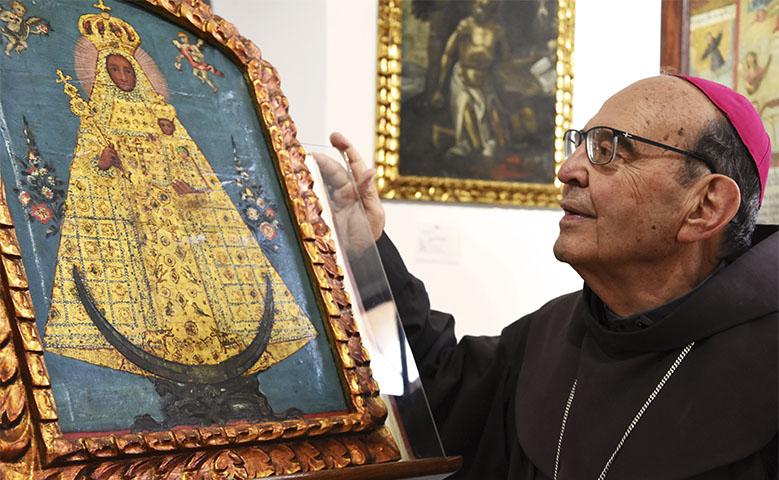History: Devotion to the Virgin of Guadalupe de la Plata
LIVE CHURCH 09.09.21 // The month of September for the Chuquisaqueños is dedicated to our Mother the Virgin Mary in the invocation of Guadalupe, congregating its faithful on September 8 celebrating the Nativity of Mary the Mother of Jesus, a party that joins the devout hearts inaround the "mamita fluala", affectionately called.Cataloged as the richest image of America.
According to the inventory of 1784 amounts to 10.565 pieces of jewelry each more precious than the other.Offerings of the Chuquisaqueñas ladies and important characters in history as the Liberator Simón Bolívar.
In a report by the Archbishop's Center for Communication, Mons.Jesús Pérez Rodríguez, Archbishop Emeritus of the Archdiocese of Sucre with 84 years of age born in Spain, but Chuquisaqueño de Corazón, inhabitant for more than half a century and witnessing several historical events in honor of our mother, expresses the deep feeling of hisContemplation, to the spiritual patron of Chuquisaca and shares the history of devotion to the Virgin of Guadalupe, a devotion that goes back in Extremadura- Spain and arrives in the time of the colony with the Fray Diego deOcaña, passing through Potosí and Charcas theYear 1601.
Virgin History of Guadalupe
Devotion to the Virgin of Guadalupe de la Plata
The devotion to the Virgin of Guadalupe was born in Spain
Faith to the Virgin of Guadalupe or Virgin "Morena" dates back to the Spanish Catholic Monarchs Fernando II and Isabel I, who had Guadalupe as the favorite figure of their devotion.
Isabel I was the one who offered a determining support for Christopher Columbus to make the discovery of America and Columbus, such as the conquerors Hernán Cortez and Francisco Pizarro, they were entrusted to Guadalupe to protect them in the colonizing campaigns of the New World before leaving inHis crossings, says Querejazu.
Once the colonial domain in America was installed, says Francisco Gil García, the Iberian conquerors mostly declared Guadalupe and therefore the order of the Jerónimos who guarded the divine image, sent emissaries to the New World to raise altars in their honor.Thus he arrives at the Royal Audience of Charcas, Fray Diego deOcaña, with the mission of replicating the image and erecting altars in the vast conquered territory that toured from 1599 to 1605.
Virgin of Guadalupe de Extremadura - Spain
In September of the year 1601, Jerónimo Diego deOcaña wasHe invited to move to his headquarters of Chuquisaca or Charcas to paint another similar.
Arrived from Spain Fray Diego deOcaña Munido de Cédulas Reales and Pontifical for the Foundation of Brotherhoods of the Virgin of Guadalupe the same account that arrived in the city invited by Bishop Don Alonso Ramírez de Vergara with whom he had met in Potosí and hadOrder that will be transferred to the headquarters of the diocese to paint an image of the Virgin of Guadalupe inspired by Extremadura.He did so settling at the house of Deam Don Juan de Larrategui who gave him everything necessary for the work, which lasted two months.
Virgin of Guadalupe de la Plata
“Finished, then the image with the wealth donated by the ladies of Alcurnia and the people, it was tried after putting it where it was in the chapel of the Bishop which is very curious and the best in the Church Mayor;and the day that was pointed out for this was the first Dominican after Epiphany;for which the bishop commanded that of all the peoples that are around the city, the priests would come with all their brotherhoods, crosses and banners, walk and dances of its people which were so many to want to tell them was difficult ”.Ocaña
Se celebraron misas el sábado anterior a la entronización, donde tuvo lugar la gran procesión con otras diversiones; corrida de toros, mascaradas, juegos de la caña, fuegos artificiales, carreras de caballos, carros alegóricos, se estrenó una comedia escrita por el mismoOcaña.
“On Saturday night the image of Deam's house was taken out and took the nun convent in the city.Although it was more than 9 p.m.They had to cancel for the water, he ordered the image not to be taken out of their home until the waters pass, which as I saw and that the expenses were already made, I said that this party was our lady's and that it was done by it, that she would return for her cause to take her out that the water would cease.
It was remarkable that just as the image left the house, the water ceased in such a way that until the nine days passed there was no drop of water;And after finishing the novenarian that same night it rained so much that we thought to be flooded ”.Ocaña
Telluric movement miracle (earthquake)
In the Capitular Proceedings there is an important mention of the telluric movement produced in the city of La Plata on November 23, 1601.Legend tells that our mother did the miracle of placating that earthquake.
“On the 11th day of the month of November of the year 1601 that was Saturday being, in the choir of the cathedral of this city with the Dean and other prebenders of that church of Charcas, hearing the Mass of Our Lady that had begun with Great solemnity and a lot of music as voices and instruments, which this church has a lot and good; being the best chapel of all the kingdoms of Peru; While in the glory of Mass, such a great tremor of land came throughout the city and region that it seemed to be that of the end of the world, because the church is vault and began to fire some pieces and the walls ran the same fate And I understanding that the Church fell, fearing to be buried there with all the others I gave a great voice saying: "Mother of God of Guadalupe FAVES US HERE"; And finished saying these words I raised my eyes and I saw the walls of the church that we had behind the back and the vault to another part, and for the opening of the sky so clear, seeing this, put my hands and entrusted to our Mrs.This hard tremor very little no more about how much one can say a hail Maria, because if it lasts a little longer there will be no stretch of the whole city.The city received a lot of damage, some houses fell and those that were so open and hurt that they spent a lot on repairing them.This was the cause that terrified people had some devotion to Our Lady and thus made the whole city a vote of celebrating a party every year ”.
In the chapter records of the Metropolitan Cabildo Archive, we find several documents in which both religious and civil authorities establish various manifestations of worship to the Virgin of Guadalupe to which the people go both in their bitterness and in their days of joy.

They determined a solemn party every year to Our Lady of Guadalupe where the Master Mr. Domingo Almeida and Mr. González were commissioned, who must communicate to the Royal Audience, for the next year a great party was made.
Sanctuary of Our Lady of Guadalupe
In the year 1812, a perpetual votive party in honor of the Virgin.In the documents that we have in view of the Cathedral Cabildo Archive, we contemplate the memorable parties dedicated to this Blessed Virgin, when the Royal Hearing chaired by General D.Juan Ramírez decrees the celebration of a party in tribute to the Virgin of Guadalupe Patrona de Chuquisaca, as an act of gratitude for the victory of their weapons that fought under the protection of the Mother of God.
The building of the same chapel or sanctuary The Bishop Vergara had requested from the Cabildo a site inside the Cathedral Church, to build a small chapel in it, whose crypt rest and its remains.This was the primary purpose to which the chapel was intended and only when the image of Guadalupe was painted, he had the idea of allocating it for her.But as it was so small and its cult extended, Archbishop Fray Jerónimo Méndez de la Tierad Cathedral.It was the year 1617
Fernando Arias de Ugarte who ruled the Archdiocese from 1626 to 1629, being promoted to the Archbishop's chair of Lima left the legacy of 10.000 pesos for the construction of an altar for the Virgin Guadalupana and instituted a chaplaincy with 250 pesos of rent for the support of its cult.It was such devotion to the Virgin that there was no prelate that it would not have detached from her rings or pectorals to deposit them at the feet of Guadalupe.With them they rivaled many canons and cappellanes of the tabernacle among the latter deserves to that of Antonio Rojas and Argandoña, which in 1784 changed the canvas of the image for a gold and silver plate.They also deserve outstanding figuration the Da chaplains.José Antonio de Vega and Fernando Ignacio de Aragón, professor at the San Francisco Xavier University, who with Munificence embellished his temple, deserving his restoration with a pontifical solemn, held by the archbishop of La Plata D.Juan Queipo de Llano y Valdez.We do not finish recounting the detachment with which they rivaled both religious and civilians, to enrich the Camarín de la Virgen with valuable gifts, their names are recorded and preserved in the old books and inventories in the archive of the Chapter Room.
Image of the Virgin of Guadalupe
Primitively the image was painted on a canvas that measured 1.26 meters.High for about 80 centimeters wide.Initially this image is painted on the canvas and all the jewels were sewn and glue.
From it, it is not discovered today more than the face of the Virgin and the Child Jesus in her arms, she was replaced in 1784 with a gold and silver plate, when the canvas were torn because of the weight of the jewels that thePeople for gratitude to their prayers donated to the image.When the then chaplain of the tabernacle d.Pedro Antonio de Rojas and Argandoña entrusted the work of the silver plate pushed to the silver.José Alcalá.It shows that the hands of the Virgin, the one that wields a golden scepter of diamonds, emeralds and rubies and the other holds the child the fingers of gold rings in high relief, so that of the original painting and nothingIt remains, except for faces.
Finally outside the pearl necklaces carried by the Virgin of Guadalupe we see countless of them distributed throughout the mantle of disheveled silver, bordering the various figures that form the mantle and whose number according to the inventory of 1784 amounted to 10.565 pieces of jewelry each more precious than the other.Cataloged the richest image of America.
Catalog with a detailed description of the jewels, their number and value would be a long job, which would occupy a separate book.But we must cite three medals of great historical value that we have seen guarded in the same image.They are a medal that carries the registration of the battle of Junín and Ayacucho, which has due to belonging to the Liberator Simón Bolívar, who made this valuable gift to the Mother of God who protected the libertarian troops of America.Another medal of immense value, is the one that the Argentine army decorated the most courageous and authentic tall-peruana heroine Mrs. Juana Azurduy de Padilla, granting her the degree of Generala of the Argentine Army.Also a medal that President Aniceto Arce's family granted Mr. Urioste, for having provided significant service, when the revolution had exploded while in the cathedral the solemn te deum was sung.
In a tiny gold trunk, a projectile is locked up that the enemies of President Isidro Belzu, shot him hurting him, when he was in the meadow and when he miraculously saved his gratitude to the Virgen del Carmen, ordering to build a chapel in thesame place where he was attacked.
The image is locked in a huge silver urn, with a great work admirably eighteently of the 18th century.Ahead is covered by a thick glass, at the foot of the image there is a pushed silver crescent, which most seems to imitate the raft used by the Indians of Lake Titicaca.
On the eve of September 8 of each year, the day enshrined by the Church to commemorate the Nativity of the Virgin and in our city to the Virgin of Guadalupe, it is practice to discover the urn, take out the image and turn on new donations.Back to its place is conducted processionally to the cathedral to sing the solemn eve with which it begins to the celebration of the traditional salves of the night and many masses in the morning and throughout the octavarian.Even the solemn pontifical mass and after it the procession through the Plaza de Armas, which concentrates the entire population and tributes in this way its veneration to the patron saint of the city of La Plata.
“I’m Bored.I Guess I’ll Research How to Make A Sindial On Google.” My kid.🤷🏻♀️
— 𝒿𝒶𝓂𝒾ℯ Sun Feb 28 23:19:16 +0000 2021
In another time when the city was a seat of the Bolivian Nation Government, these parties were more solemnity with the assistance of the head of the Nation with its ministers, diplomatic corps and army in a gala suit.In the night the 25 de Mayo square lighting up, an army band played a toilet, the temples mainly illuminated the Cathedral Church.This time the famous bullfights, celebrations imposed by the colony could not be missing.
Concluded the cults taxed by the Metropolitan Cabildo and Catholic people of Sucre, in its cathedral church the image of Guadalupe to its tabernacle is again transported, where another week of religious worship begins, of fame for the amount of masses that were celebrateddaily with pomp and solemnity.
The people with their peculiar simplicity, usually accompany these public cults with the popular couplets field that carry a very sense folkloric tint.
Virgin of Guadalupe Spain (Extremadura)
According to Roberto Querejazu, faith to the Virgin of Guadalupe or Virgin "Morena" dates back to the Spanish Catholic Monarchs Fernando II and Isabel I, who had Guadalupe as the favorite figure of his devotion.
Isabel I was the one who offered a determining support for Christopher Columbus to make the discovery of America and Columbus, such as the conquerors Hernán Cortez and Francisco Pizarro, they were entrusted to Guadalupe to protect them in the colonizing campaigns of the New World before leaving inHis crossings, says Querejazu.
Once the colonial domain in America was installed, says Francisco Gil García, the Iberian conquerors mostly declared Guadalupe and therefore the order of the Jerónimos who guarded the divine image, sent emissaries to the New World to raise altars in their honor.Thus he arrives at the Royal Audience of Charcas, Fray Diego deOcaña, with the mission of replicating the image and erecting altars in the vast conquered territory that toured from 1599 to 1605.
Coincidencia fortuita, que el obispo de Charcas se encontrara en Potosí justo en ese preciso instante cuandoOcaña realizaba la réplica de la figura guadalupana, tanto que podría ser una acción de la providencia divina a la que aún no se le ha dado mucha relevancia por los fieles de la Mamita.
There is a first myth about the creation of the Virgin of Guadalupe de Sucre. La historiografía se encargará de desmentir este “milagro”, ya que resulta difícil creer queOcaña haya sido enviado a América a replicar imágenes de la figura santa, sin tener nociones de pintura. Sin embargo, se reconoce el afán del creyenteOcaña, de brindarle un contorno milagroso a la creación de la imagen de la “Gualala”, acaso para cumplir su misión de impulsar la fe y devoción de los católicos platenses.
Myths a finding?
A second myth about the appearance of the Virgin of Guadalupe, who persists until these days, is collected in one of his versions by Felipe Costas Arguedas, in his dictionary of Bolivian folklore.In its pages it tells how a donkey that loaded a box, frequented a pasture near the cathedral and that the animal ran in terror when the curious interns for seeing that there were in its load approached it.After several unsuccessful attempts to hunt the beast, the ecclesiastical authorities were attended with which the animal reacted meekly, letting disassemble its load.To everyone's surprise, the box contained the image of the Mamita Guadalupe.Then it was determined that in those grasslands the chapel would be built for its rest and would be appointed patron saint of the city, since the events of its finding were interpreted as a divine design.
This myth probably developed after the events described by historiography. Y esto se podría explicar también por la importancia de que la fe reviste para los creyentes, como se verá al seguir la narración del Monje JerónimoOcaña.
The scenic representation probably moved the public and fed his faith in the divine power of the new Patroness of La Plata, however it was evident that miracles were still oblivious to their context.The myth of the appearance by divine intersection of the Virgin loaded by that jealous beast, which was torn before the ecclesial authorities to reveal his treasure, would be a first way to recognize a first miracle of the "Gualala" in the new American lands, whereNow he exercised his divine power.Again the fervent need of the faithful to feed the faith.
Since then the miracles of the Mamita "Gualala", the myths and legends, if they want to be called that, did not stop, feeding the faith of the believers.
That this year again it will be reaffirmed and celebrated with the celebration of the Virgin of Guadalupe, as has been carried out for centuries in early September, with the continuous variations imposed by the passage of time and with the permanent component of renewing the faith of Catholics.
The various forms of the expressions of faith to the present
While the celebration of the spiritual patron of Chuquisaca is one of the central acts of the Catholic life of the region since 1601, throughout the centuries the celebration has inevitably evolved.
Already at the time of the colony it was traditional.
The celebration ended in the chapel of El Apert.This would be the first dance that was practiced for the celebration of the Virgin, explains researcher Felipe Medina.
Already in the twentieth century, the practices related to the celebration were maintained in a similar way, preserving tradition as a symbol of devotion.
But since 1987, the celebrations committee incorporated a variation in the program, which will become the now traditional entry of the Virgin of Guadalupe.The Organizational Committee included a group of devotees that are now known as the "gualalas" whose president is Mrs. Aida Peredo de Acosta, who promoted the first forms of a folkloric parade in honor of the Virgin.
Peredo recalls that since then they, the gualalas, have been responsible for organizing this parade under the only motivation of their devotion to the mommy.
Who causes Sucre so much joy?The Virgin Santa de Guadalupe!
Bibliography:
Archdiocesan Arch.Julio Garcia Quintanilla from 1963
-“Recorrido del nuevo mundo” (Manuscrito Fray Diego deOcaña, Orden de los Jerónimos)
Cathedral Museum - Nicolas Ortiz Street, 61 Sucre
Recoleta Museum - Polanco Street 162, Sucre
Gratitude:
Monsignor Jesús Pérez Rodriguez, Archbishop Emeritus of the Archdiocese of Sucre (Q.D.D.G)
Lic.Iván Gutierrez, Cathedral Museum Director
Kenny Prieto Bellido, seminarian
Reportage:
SUCRE COMMUNICATION ARZOBISPAL CENTER - LIC ADDRESS.Mishel Lescano Durán.







